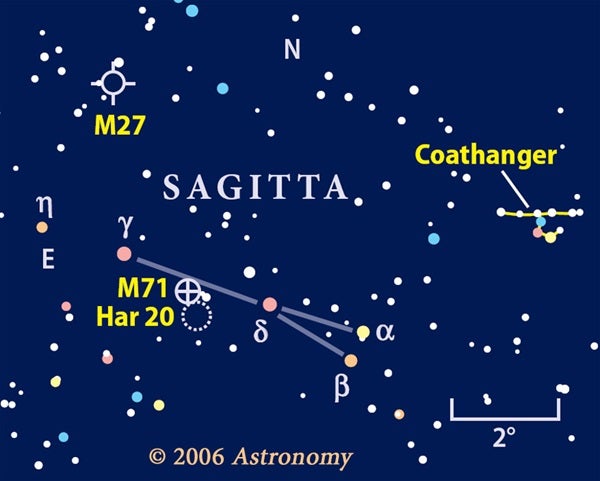Sagitta gets its shape from five faint stars that lie about a third of the way from Altair to Deneb along the eastern side of the Summer Triangle. The small constellation may just squeeze into your binoculars’ field of view, giving you a great chance to compare the stars’ brightnesses and colors.
Two of the stars along the arrow’s shaft, labeled Delta (δ) and Gamma (γ) Sagittae, are red giants, while Eta (η) Sagittae — at the arrow’s eastern tip — is an orange giant. The two tail-feather stars, Alpha (α) and Beta (β) Sagittae, are yellow giants. Soften your binoculars’ focus just a bit to enhance the stars’ subtle colors.
The arrow also contains a pair of challenging star clusters near 9 Sagittae, a dim star midway between Delta and Gamma. The first, M71 (NGC 6878), is found just to the star’s east-northeast. Look for the cluster’s dim splotch of grayish light against a starry backdrop.
For years, M71 remained a mystery: Was it a densely packed open cluster, like the Wild Duck Cluster (M11) in Scutum (discussed in this column in the September 2005 issue, “Open a star window”), or was M71 a loosely packed globular cluster? Early analyses were inconclusive, but recent studies using improved techniques prove M71’s status as a globular cluster, albeit an unusual one.
Although some 15 to 20 stars call this cluster home, their combined light equals only 8th magnitude, which can make the cluster tricky to spot through binoculars.
Okay, those two targets may be a little daunting, but you should have no trouble with the next. In fact, it can even be seen faintly by the naked eye under dark skies. The Coathanger asterism lies just across the border in the constellation Vulpecula and looks amazingly like its namesake through binoculars. To find it, aim toward the arrow’s tail feathers, and then look about a binocular field to the northwest (up and to the right).
9The shape amazes new stargazers, although, from the Northern Hemisphere, the Coathanger hangs upside down. Six stars aligned in a straight line form its crossbar, while four other points of light curve away to create the hook. The Coathanger is one of my favorite binocular targets in the late summer sky, even if it isn’t a bona fide star cluster. Data gathered by the European Space Agency’s Hipparchos satellite a decade ago prove the stars align by chance, with each lying anywhere from 220 to 1,100 light-years away.
Our last target this month also resides in Vulpecula, but it is most easily found by starting at Eta Sagittae, which marks the arrowhead. Wind your way northward along a zigzagging line of half a dozen faint stars that lead to a tiny blur of dim light. This is M27 (NGC 6853), the famous Dumbbell Nebula. Its shape appears rectangular through 7x and 10x binoculars, while higher magnifications hint at its characteristic hourglass profile. The first planetary nebula ever found, M27 is the still-expanding shell of gas a star expelled 3,000 to 4,000 years ago.
When Heracles shot Sagitta into the air, he may have missed Aquila, but he struck gold for binocular observers. The next chance you get, pay Sagitta a visit and enjoy its unique sights.











